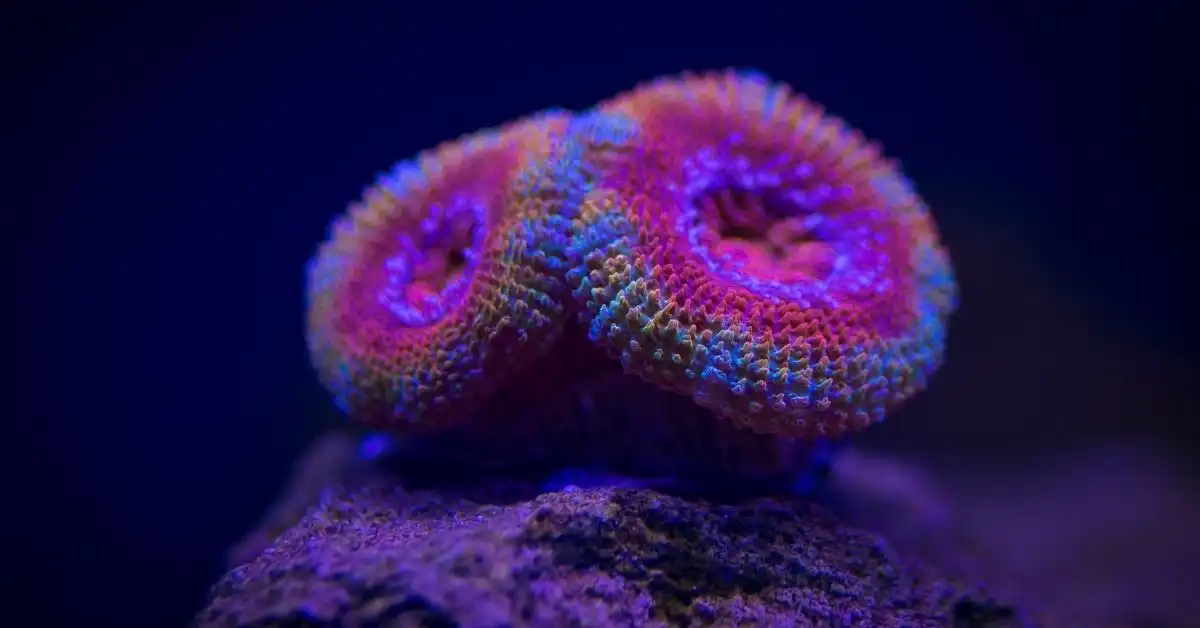Corals are the most lovely addition to your aquarium reef. They add vibrance to your collection. This is why it’s all the more worrying when your coral goes pale.
Why is your Acan coral dying?
The most likely cause can be exposed to too much light. Also, placing your corals too close to each other might be responsible.
Unstable pH and enzyme levels can cause corals to stress and die too. Lastly, overfeeding can also cause corals to die.
But this is just a summarized answer. We’ve jotted down the 5 most common reasons and their possible solutions.
Symptoms of a Dying Aquarium Coral
A dying coral can be painful, both for your heart and wallet. So, look out for the following symptoms. This way, you’ll be able to take immediate action if any signs appear.
Sign 1: Loss of Color
Corals exhibit awe-spiring colors when they are healthy. Loss of color is the primary symptom of an unhealthy or dying coral.
If your coral looks white and nearly transparent in water, it might be dying. This is unless the coral is normally white.
Sign 2: Seaweeds Growing on the Coral
If a coral is healthy, other saltwater plants shouldn’t be able to live off of them. So, if seaweeds are growing on your coral, there is a chance it might be dead.
But, if small plants only take root in the coral, you can still save it.
Sign 3: Blotches and Dark Spots
Blotches and Dark spots are seen in diseased corals. They can vary based on what disease the coral is suffering from.
Usually, the bacterial infection causes these. This can be cured, but other species in the aquarium might be affected.
So, the best action is to replace the dying coral with healthy coral.
Reasons Behind Acan Coral Dying
If your coral shows any symptoms of dying, it’s important to figure out possible reasons. Once the reason is determined, we can work on solving them to save your coral.
Let’s look at the 5 reasons behind dying corals-
Reason 1: Too Much Light
The most common reason for coral dying is their exposure to light. Corals have very reactive skin.
Plus, they are deep water species. That’s why keeping them too close to a light source will cause them to die. This is also a reason behind candy cane corals dying.
Solution: Change the Lighting Setting
Keep your Acan corals from mid to low positions in the aquarium. Make sure they are receiving light at low intensity.
Acan corals can get used to moderate to higher settings of light. But this needs a high level of patience. It has to be very slowly adjusted to slightly higher settings of light.
It’s best to keep them under blue LED lights as their color pops more. The optimal light should have a PAR of 150 to 200 range.
A T-5 light also brings out vibrant colors in the coral. You can also upgrade the bio cube LED you have. That will be useful too.
Reason 2: Alkalinity Swings
If your Acans are dripping, chances are the tank is going through alkalinity swings. LPS corals can survive in alkalinity ranging anywhere from 7 to 11 pH.
But, swings in pH value can cause Acan corals to die. This happens even if swings are in an acceptable range.
Solution: Fix the Alkalinity and Monitor it Regularly
Monitor your tank’s alkalinity every week at least. Monitoring only when noticing problems won’t help.
Because the reading might show 8, which is acceptable, but it could have been 10 two days ago.
This swing could’ve caused the problems. So, monitor regularly to prevent it.
Reason 3: Tight Placement
Placing the corals too close to each other provokes warfare. This is particularly the case for LPS corals. And, unfortunately, Acans are LPS corals.
Corals have sweeper tentacles, which they use to fight other corals. Plate corals can die, too, due to tight placement.
So, placing incompatible corals next to each other might cause some to die.
Solution: Fix the Placement
The rule is to have a gap of 5 inches between corals to avoid warfare. So, if this isn’t maintained, change the placement to ensure the gap.
Alternatively, you can check for compatibility. Some corals are compatible with each other. But some aren’t.
For example, Acan Echinata will kill the Acan Lord if placed next to each other.
Reason 4: Feeding
Overfeeding Acan corals is a problem. This is because the excess food is liable to start rotting inside them.
Solution: Feed When Needed
You can try target feeding your Acan corals 1-3 times a week. We recommend doing this at night as their tentacles are most present then. Just make sure to feed each head.
Reason 5: Metal in the Water
A surge of metal in the water can be caused by faulty equipment. This is risky because it cannot be detected by your home test kit. So, if this is left unchecked, it can slowly kill all your fish.
Solution: Inspect and Change Metal Level
Everything in your tank may show symptoms of weakness or is dying. That’s a sign of metals being present in the aquarium.
You can detect metals with an ICP test. You can also inspect all of your tank equipment for damage.
Then check for magnesium levels in reef tanks. Try lowering magnesium levels in water by a water change with a lower magnesium salt mix.
FAQs
Question: How many types of Acan corals are there?
Answer: There are two types. Acan Lords and Acan Echinata. But placing them together in one tank can be hazardous as they are competitive.
Question: Which foods are most popular for Acan corals?
Answer: The foods most popular for Acans are Reef Roids and Vitalis LPS Coral pellets. These can ensure good health.
Question: Where are Acan corals most abundant?
Answer: In Vietnam and Australia. They are most abundant in these two countries.
Conclusion
So, that’s all we have on ‘Acan coral dying’. We hope we’ve been able to help you narrow down what’s causing this and how to solve them.
If your coral is still in critical condition, consider taking them to an aquatic vet.
Good luck!


